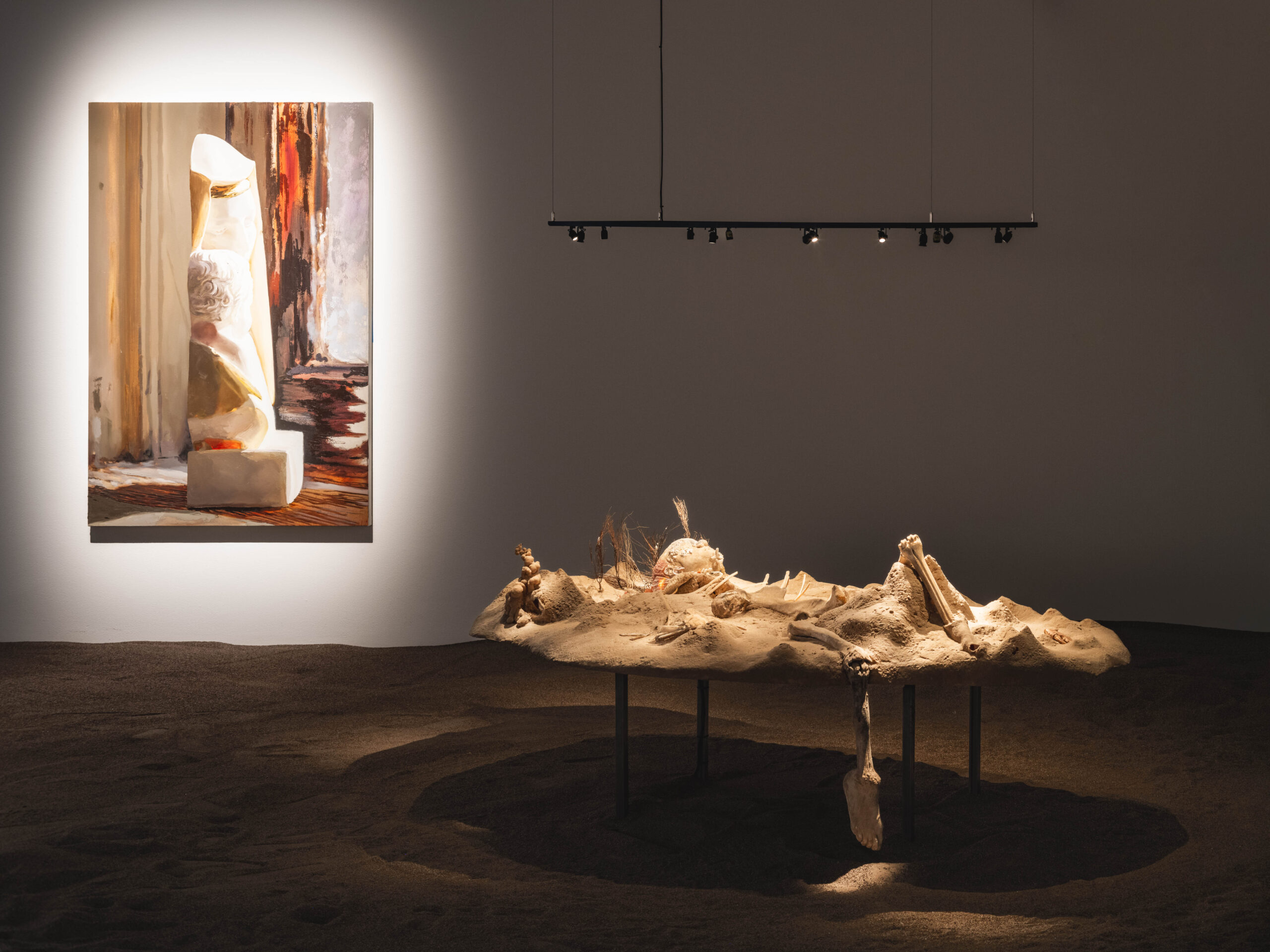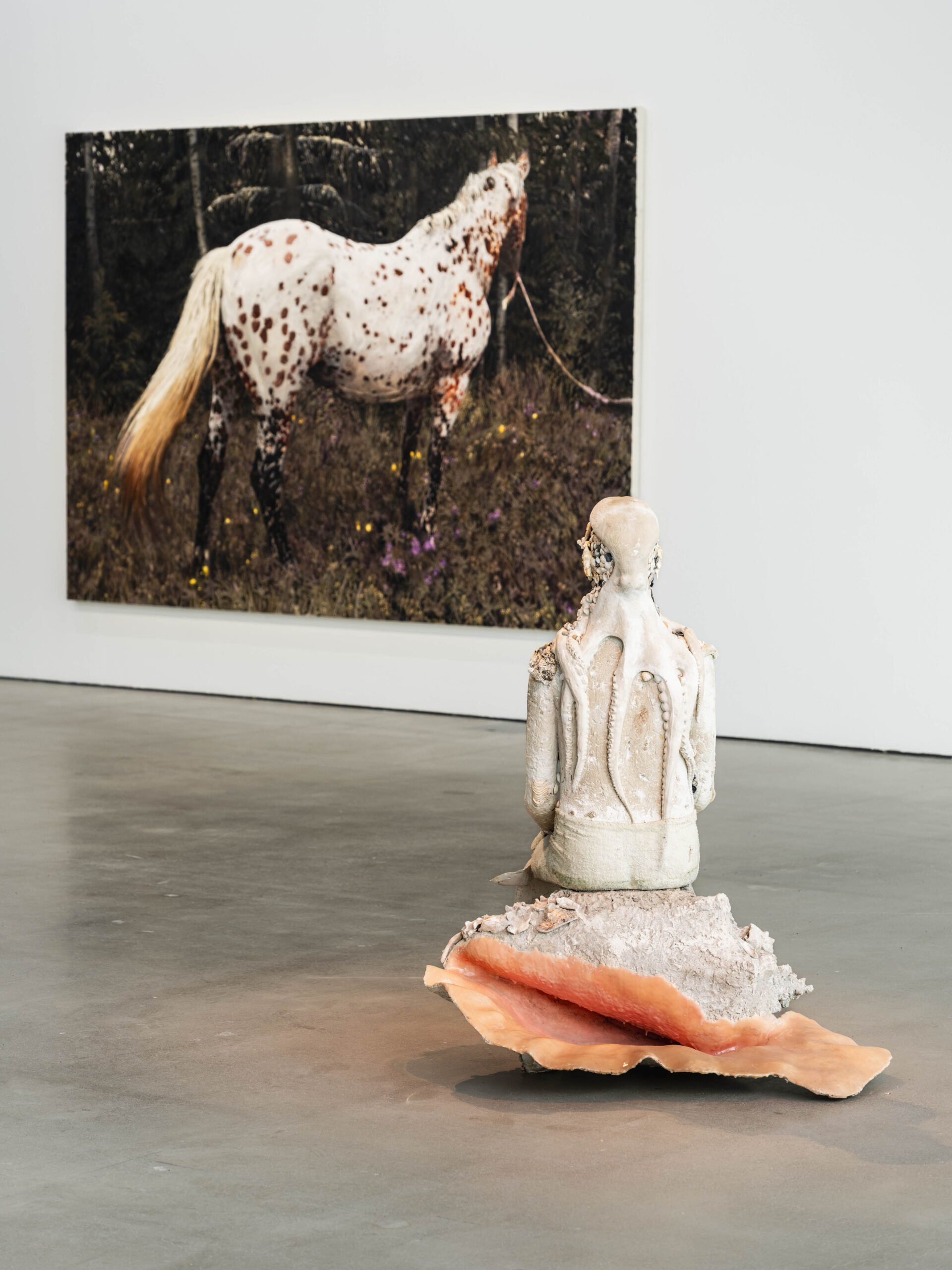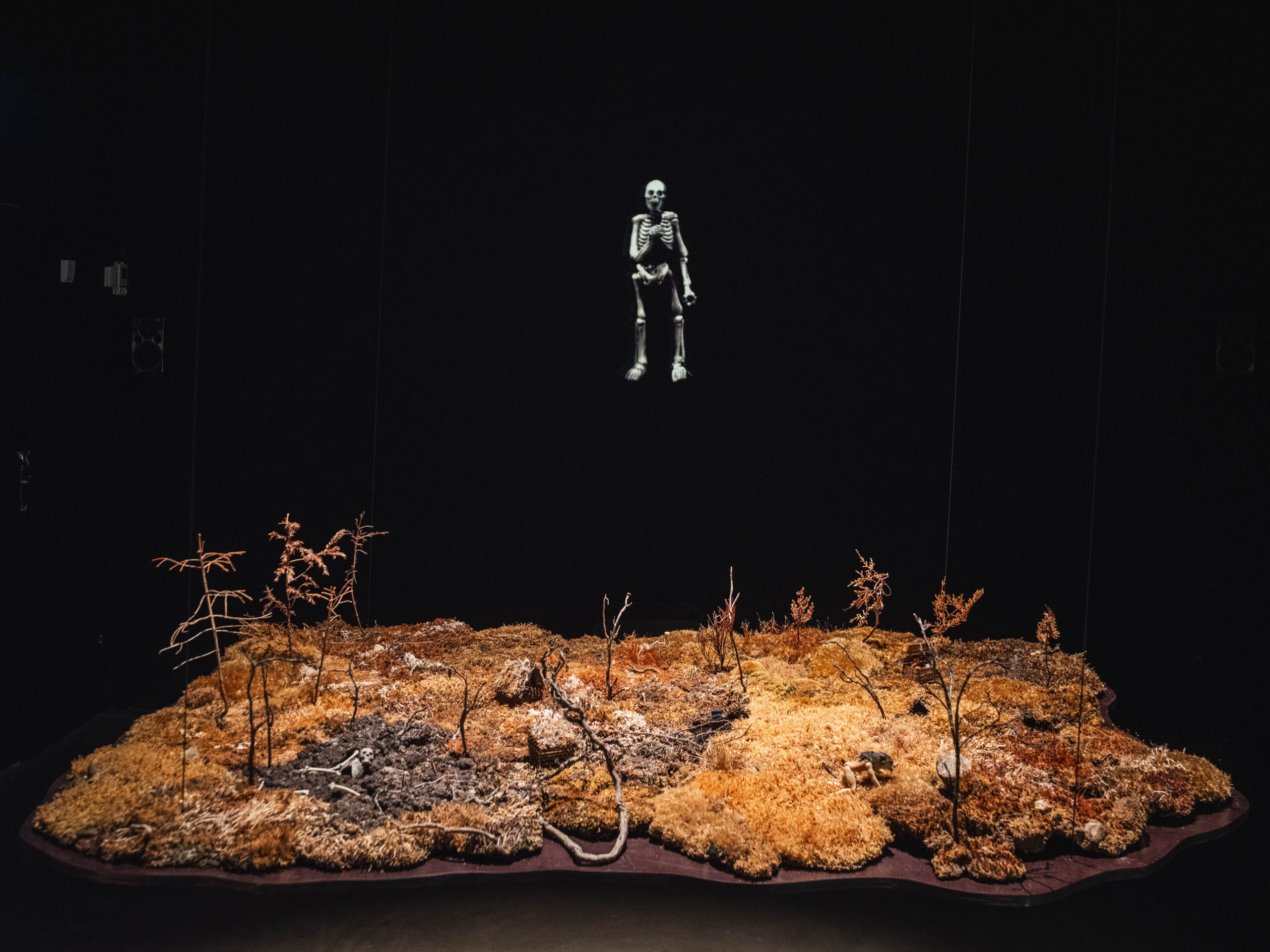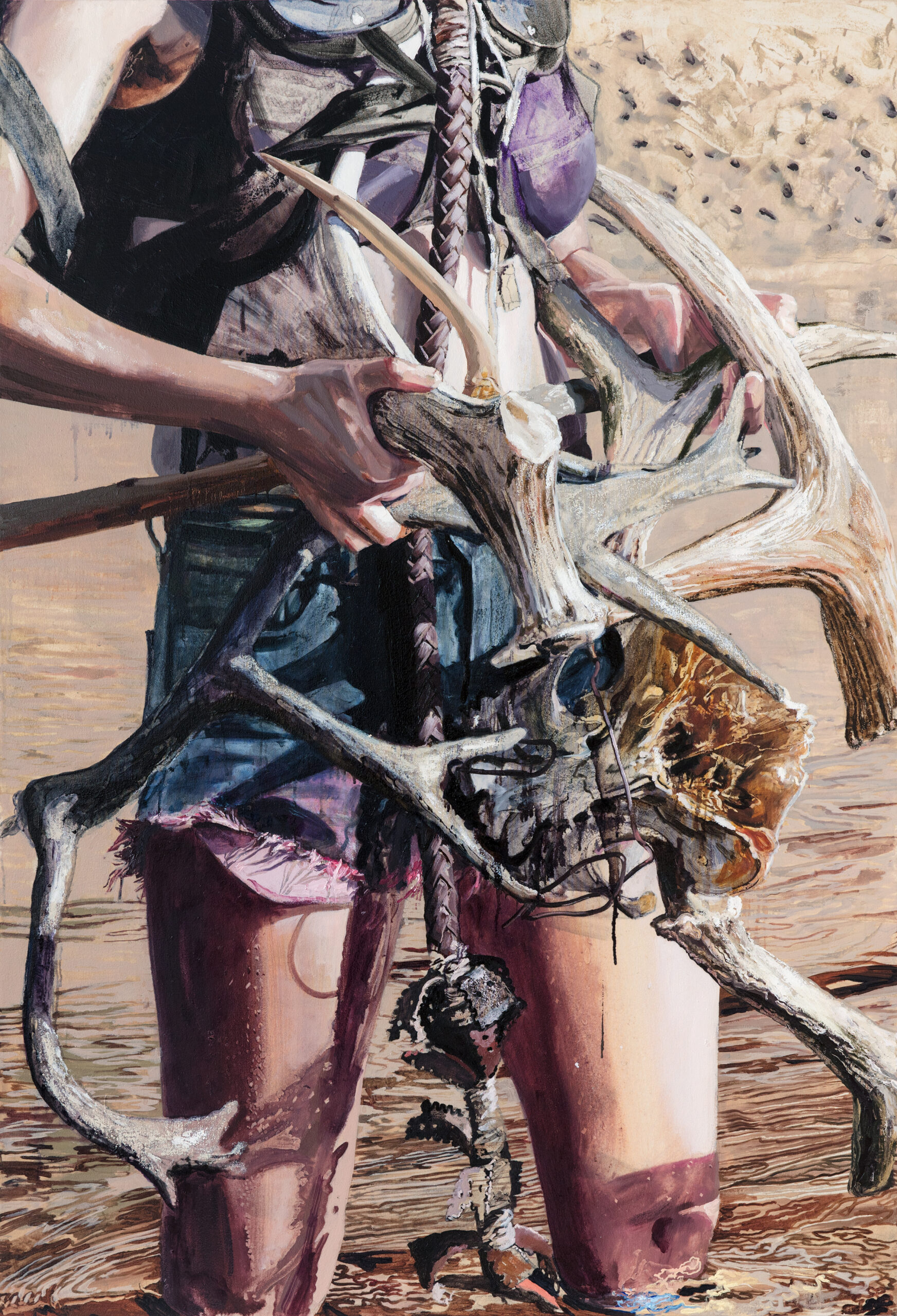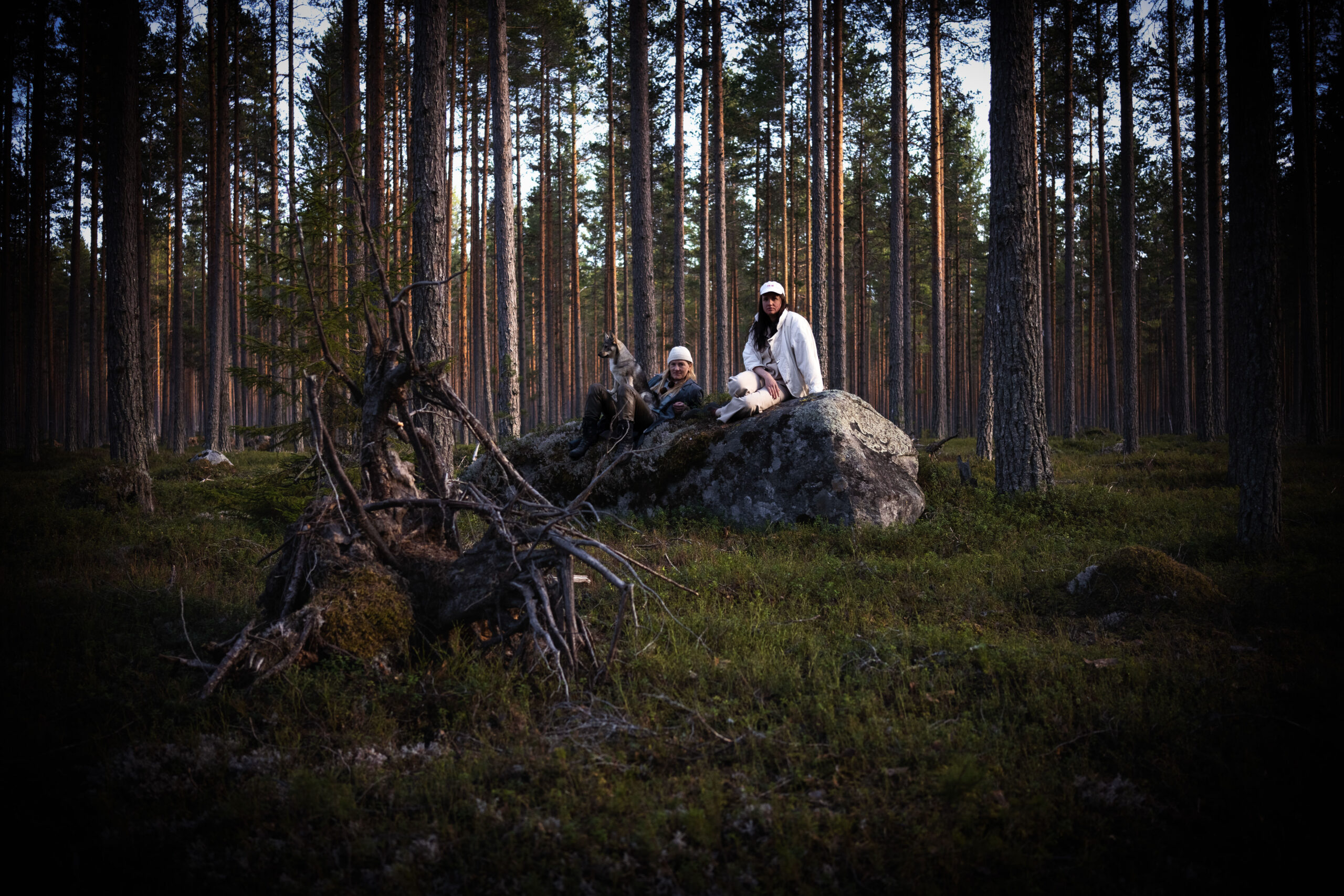In different ways, the artists portray places, situations and the forces that instigate events, but they share the urge to convey something that lies beyond the image; the dominance of history over the present, and the powers that individuals must navigate in order to be in this world. When Sara-Vide Ericson paints a solitary horse that has turned away, she tells of every time a hand has longed in vain for the warmth of a caress where two bodies could have met. When Tilda Lovell in her small wall-mounted sculpture lets a pliable human hand be the body of an animal of unclear species with its eyes turned skyward, she tells of the doubt-defying battle that is a condition of life.
Sara-Vide Ericson & Tilda Lovell
30 aug29 oct 2023
The surroundings are co-creator, motif and material for the artists, who are both based in Hälsingland. Tilda Lovell finds most of the shapes and contents for her sculptures in the countryside around her studio. An almost instinctive search and gathering process precedes her revolutionary creative rites to intensify and exalt the raw material. Sara-Vide Ericson’s persevering experiences of the ground, damp, scents and temper of places is crucial to being able to paint them. In the way that biotopes are sites with a range of temperaments, the different rooms in the exhibition are envisaged as moods of varying intensity, where works by the two artists meet. As visitors move through the kunsthalle, they will experience murky forests, silent, dry sand landscapes, wetlands and flowing or still waters. Each type of habitat has characteristics that suit certain organisms, but beyond the chimera of balance, they are forever subject to intense power struggles, where a human is nearly always one of many rivals.
Both artists are interested in the test of strength that goes on in physical reality, where the individual comes up against giants such as time and forces of nature. But an ominous darkness, powers beyond the field of vision, the treachery on the other side of a dividing wall, also lies in wait in their works. The title of the exhibition is from a line in a poem by Tomas Tranströmer, The Palace (1962), as a reminder of that which exists beyond what we can perceive with our bodies. Poetry has been helpful for understanding, or rather, sensing what happens in the space between the two artists, the approaches that make their works alternately chime with each other and clash.
Tilda Lovell creates sculptures, reliefs and installations, often with video, shadow play or sound. She has mastered many materials and techniques and makes works for exhibitions and public environments. Her practice often combines absurdity and seriousness, lending humorous touches to the duskiest corners. In her domains, bodies from the mineral, plant and animal kingdoms seem to merge into undefinable figures, which renegotiate how we can inhabit the world by talking openly about coexistence. In the big cyclical order of creation, metamorphosis and decay, curiosity, desire and understanding exist alongside constant competition.
Many of the scenes that Tilda Lovell portrays are populated by creatures that seem to have writhed their way out of the earth and other matter to become flesh. The installation Celestial Bodies (2014–2023) consists of several small ink drawings, prints and sculptures. Here, we perceive dimensions that are usually only perceptible to the mind, with figures that are normally beyond the reach of eyes or hands. The oblong darkness contains forms and notions that consort with our subconscious. An inverted photo of a freckled thigh opens up the firmament, and we are reminded that not only the imagination harbours things we cannot perceive; the natural sciences have shown many forces in the universe that exist and affect us, even if we cannot see them.
In another installation, Myren (The Mire, 2021), also by Tilda Lovell, a sculpted landscape and an animated projection tell of people seeking to be delivered from evil and instead finding beauty. The work relates to folklore and the Bible and sparks thoughts on why spiritual beliefs arise and are used in human communities. With its unique environment and dreamy bottomlessness, the mire is a place of mythical beings and is both background and main motif here. The question of how we find knowledge infuses the exhibition: how narratives, physical experience and dialogue with the supernatural through ritual and other communications are needed in order to understand and be in the world. The Lab (2020) by Sara-Vide Ericson shows someone wrapped in a garb of leather and copper vessels; we see her hands, chest and lips. The artist calls her The Miner, a meth lab on wheels, where alchemical methods, theological and classical symbols and jingling bells are summoned to represent our image of purification and prayer. Worshipped, yet subject to all kinds of possible and impossible desires and expectations, she stands like a vessel in her own right, armed and filled with whatever the viewer desires.
Sara-Vide Ericson bases her paintings on personal and physical experiences. Her work in the studio is preceded by performative work, processes over long periods of time, which are documented as temporary actions. Memories of the place, the moment and the inherited history are transformed by the artist in a battle with and against the materials into a condensed new reality. Ericson has a traditional approach and paints in oil but also uses a variety of tools to apply the paint and foreign materials, such as horsehair, blood and powdered marble. In recent works, the paintwork is more impasto and physical, but with the same exactness and sensitivity to details, light and materiality. Sara-Vide Ericson often appears in her own works, but she does not regard them as self-portraits; instead, she plays different roles and lends her body to the paintings.
Sara-Vide Ericson’s practice may be based on a deep knowledge of places and things, gathered with her body, but her works speak of that which acts beyond experienced reality. A protagonist returns in several works, with veritably ceremonial actions to renegotiate life’s conditions. She combines significant objects with the elements at a carefully defined time, so what was once heavy becomes light. In the painting The Percussionist (2019), we meet her just as she prepares to start, like an orchestra conductor on the first note, encouraging the first step of a march to resurrection. In denim shorts and a purple bra, she carries the antlers of a few of the local large wild animals and a sturdy horse whip – the balance of power will soon be renegotiated!
After the artists had been invited to exhibit together, a discussion began, where they became more deeply involved in each other’s practices. They already knew each other, but this prompted a special kind of conversation, which eventually gave rise to the choice of works and presentations in the different halls at Bonniers Konsthall. The works by the two artists are either long chains of events that require their own space, or placed in dialogue with each other. You are now welcome to enter the many worlds that these works open. Step inside!
Thanks to Swerock.
Biographies
Tilda Lovell (b. 1972) graduated from the Royal Institute of Art in Stockholm in 2003 and has since then participated in several group exhibitions and solo shows, including at Anna Bohman Gallery (2022), Turku Art Museum and Norrtälje konsthall (2017), and at Göteborgs Konstmuseum when she was awarded the Stena Grant in 2017. Group exhibitions include Shapeshifters at Malmö Konstmuseum and Isolering at Färgfabriken in Stockholm, both in 2020. Lovell has produced a numerous public works of art in Sweden and has received several awards and prizes, including the Maria Bonnier Dahlin Foundation grant in 2003. She is represented in a number of private and public collections.
Sara-Vide Ericson (b. 1983) graduated from the Royal Institute of Art in Stockholm in 2009 and has exhibited regularly in Sweden and internationally since then. Her works have been featured in solo exhibitions by institutions such as Kulturhuset Stadsteatern in Stockholm, Kalmar Konstmuseum and the Royal Academy of Fine Arts in Stockholm, and at galleries such as V1 Gallery in Copenhagen and Galleri Magnus Karlsson in Stockholm. Group exhibitions include Our Red Sky at Göteborgs Konsthall (2020) and The Trees, Light Green: Landscape Painting – Past and Present, at Bonniers Konsthall (2019). A solo exhibition of Sara-Vide Ericson will open at the Swedish Institute in Paris in autumn 2023. Ericson is represented in a number of private and public collections in Sweden and abroad, and she is the recipient of numerous art grants.
Both artists are currently active in the County of Hälsingland.
Curator: Susanne Ewerlöf
